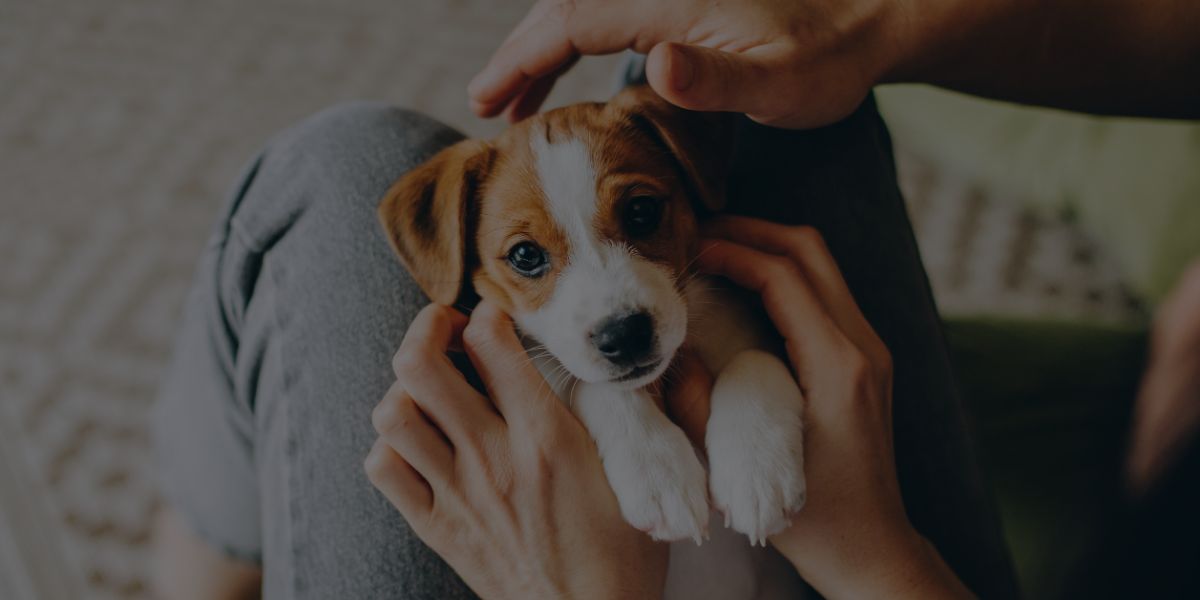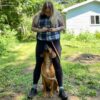So, you’ve decided that a puppy is the right pet for you? Congratulations! Owning a dog can be an incredibly rewarding experience – but there are also some things you need to know before taking the plunge. This article will serve as your ultimate guide on what to know when getting a puppy for the first time!
From the do’s and don’ts of getting a puppy to need-to-know checklists, you’ll discover the tips and tricks of finding (and raising) the right pup.
On that note, let’s get started!
What People Don’t Tell You About Getting a Puppy…
Before you jump into puppy ownership, there’s something important to consider: puppies are a lot of work. They require a tremendous amount of time and commitment – and they don’t come with the same unconditional love an adult dog would.
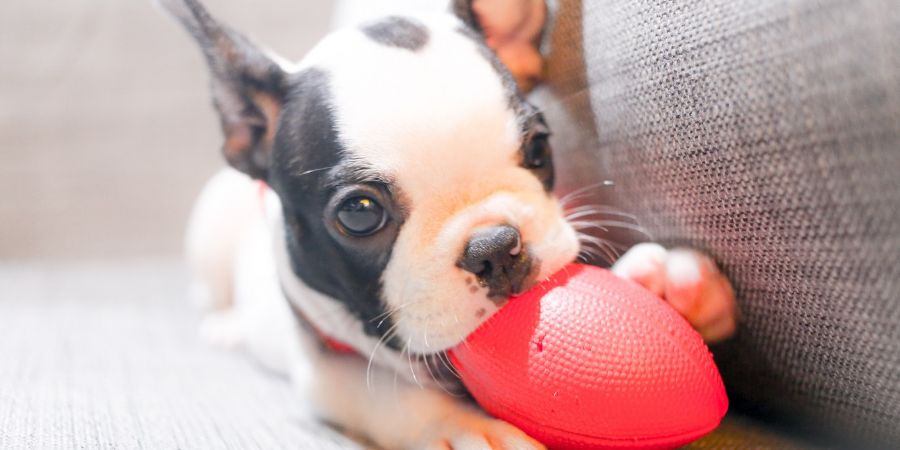
What to Know When Getting a Puppy: 5 Facts You Might Not Have Considered
1. It’s very time-consuming.
Puppies need a LOT of attention. Not to mention, they require almost constant supervision… And if they don’t get either of those things, they can easily get into trouble. (Think: chewing on furniture, having accidents in the house, and so on).
From potty training to obedience classes, you’ll be extremely busy within those first few months!
2. Puppy-proofing your home is a must.
Puppies are notorious for chewing on things, from furniture to electrical cords and anything in-between that they can get their mouth on. So, make sure you take the time to puppy-proof every corner of your home to prevent your pup from getting into any trouble.
3. Dog training is essential.
You’ll want to start your pup’s training as soon as possible. After all, the sooner you can instill good behaviors, the easier it will be to maintain them in the years to come. Your puppy needs to learn basic commands like sit, stay, come, etc. Furthermore, they also need to learn how to behave in different settings (going for walks, meeting new people, etc.).
So, invest in a few classes and/or books – or even consider hiring a professional trainer if you feel overwhelmed.
PRO TIP: In as little as 3 months, you can also learn how to train your puppy (as well as get paid to train other people’s dogs) by taking QC Pet Studies’ self-paced, online Dog Training certification course!
4. Vaccinations are mandatory (and spaying/neutering is also strongly recommended).
Puppies need certain vaccinations to stay healthy, and it’s very important that you keep them up-to-date. More to the point, they’re not an option. Within the first year, your pup will need the following vaccinations:
- Rabies;
- Distemper/parvo;
- Bordetella;
- And Lyme.
On top of that, you should also strongly consider spaying or neutering your pup. This not only helps control the pet population but can also reduce certain behaviors like aggression. Plus, it can help reduce your pup’s risk of developing certain health issues later on in life (such as cancers).
So, make sure to talk to your vet about the right time for these procedures. And in the months leading up to getting your puppy, make sure to put aside the money that’ll be required for these procedures.
5. Puppies are basically toddlers.
There’s a reason why many would argue that puppies are like toddlers – they require almost the same attention, care, and time. Furthermore, they cry (a lot) and will throw the puppy equivalent of a temper tantrum if they’re overtired and aren’t having naps enforced.
At the end of the day, it’s important to remember that puppies are still very much babies. As such, they’re going to act out sometimes, they’re going to have an attitude, and they’re going to be handful. As frustrating as it might make you feel at times, remember that your puppy must be met with love, understanding, and patience.
Trust us – this will be rewarded by years (and years) of unconditional love from your new four-legged friend… And they WILL eventually settle down once they mature!
Making the Right Choice: Your Getting-a-Puppy Checklist
Now that you have a better understanding of what it takes to get a puppy, you’ll want to make sure you have all the necessary supplies before bringing your new pup home.
Essential Supplies When Getting a Puppy
Here’s our checklist to help make sure you’re ready:
- Nutritious, age-appropriate puppy food and water bowls
- A comfortable crate or bed
- Collar with name tag
- One or more leashes
- Puppy shampoo
- A brush and comb
- Age and size-appropriate nail clippers
- Dog treats for training
- Toys
- Chew toys (to help ease discomfort when their razor-sharp puppy teeth start falling out – and also, to stop them from chewing on your furniture, hands, etc.!)
- Clean-up supplies (such as pet wipes, spray, and a portable vacuum cleaner)
- Puppy pads to help with potty training
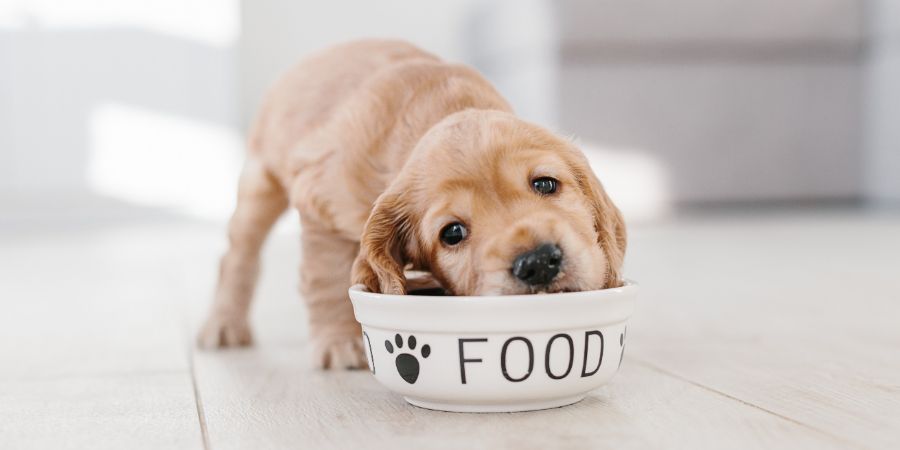
Getting Pet Insurance
While on the topic of essential must-haves, it’s also a good idea to purchase pet insurance for your pup. That way, if they become sick or injured and you need to take them to the vet, you’ll be financially covered. Plus, some policies will even cover things like preventative care and routine check-ups.
It can be all too easy to disregard pet insurance because you don’t necessarily need it in the here and now. However, if something does go wrong, you can wind up paying thousands of dollars out of pocket if you’re uninsured. And the thing about unexpected emergencies is that they’re, well, unexpected. So, would you rather be safe than sorry?
What to Look For
When shopping around for different providers, remember that the cost of pet insurance varies depending on your pup’s breed, age, and existing health conditions. So, do your research and look around until you find a policy that works best for you and your pooch!
And if you’re on a budget, look for providers that offer discounts and specials to help you save money. Moreover, search for insurance providers (such as Trupanion, for example) that allow YOU to customize your policy. This way, you can pick and choose what kind of coverage is right for you – as well as how much you’re willing to spend per month.
Buying a Puppy: Where to Look
Now that you know how to prepare for getting a puppy and the essential supplies you’ll need, it’s time to start looking for your perfect pooch!
Where NOT to Look: Pet Stores
We strongly advise avoiding pet stores when shopping for a puppy. Why? Not only do these puppies often come from unethical and inhumane breeding practices, but they usually have not been properly cared for or socialized.
Plus, the price tag won’t be worth it. You’ll end up paying more than if you got your pup from another source (such as a rescue or shelter).
Where to Look Instead: Shelters, Rescues, and Private Breeders
The best place to look for your puppy is at shelters and rescues.
Here, you can adopt pups that have been abandoned or surrendered by their previous owners. Not only will you save money this way, but you’ll also be giving a pup in need a second chance at finding the perfect home. Plus, shelters often have older puppies and younger dogs available, so you have a wider range of options.
However, if you’re set on getting a purebred instead of an adopted mixed breed, then your best bet is to look for reputable private breeders. You can find breeders online (just make sure they’re legitimate) or through recommendations from people you trust. Just make sure to do your research first before committing, as puppies from these sources tend to be more expensive.
Lastly, you could always try online sites such as Petfinder to look for your pup. Remember, though, to do your due diligence before making the purchase. In particular, be sure to check reviews from past customers who have purchased puppies from the seller.
No matter how you go about finding your perfect pup, again, you want to be careful that you’re not unintentionally supporting puppy mills. The best way to avoid this is to ask questions and see the puppy in person before bringing them home.
Buying a Puppy Without Seeing It in Person
If you’re not able to see the puppy in person prior to purchase, there are a few things that can help put your mind at ease. First, make sure you ask the seller for photos and videos of the pup so you can get a better understanding of their environment and health.
Second, check with the seller’s local humane society or SPCA for any reports of abuse or neglect. Additionally, ask the seller for references from prior customers who have purchased puppies from them in the past. Lastly, check out online reviews of the breeder to get a better idea of their reputation and trustworthiness.
What to Look For in a Puppy Personality
When looking for a puppy, it’s not just important to consider their physical health; you also want to make sure they have the right personality and temperament.
As puppies are still developing, they often have an unpredictable and energetic nature that can make them difficult to handle. To help ensure you get the right pup for you and/or your family, ask some questions about the litters’ parents.
Are they social and friendly, or do they have any aggression issues? How well do the puppies interact with humans? Do they enjoy being around other animals?
If you can’t find out this information ahead of time, then it’s especially important to observe the puppies in person. This way, you can see which one is better suited for your lifestyle and home environment. You should also look for the following traits:
- Affectionate and well-socialized
- Good with children
- Easy to train and eager to please
- Obedient and eager to learn
- Not overly aggressive or shy
Now, what happens if you experience love at first sight with a puppy who doesn’t meet the above criteria?
While you shouldn’t give up on them, it’s important to be realistic about the amount of training and socialization they’ll need to meet their full potential. Most importantly, remember that puppies (and all animals!) are living beings with unique personalities. Even if they don’t fit into an ideal mold, your pup is sure to bring love and companionship into your life.
So, go with your gut and choose the puppy that YOU want!
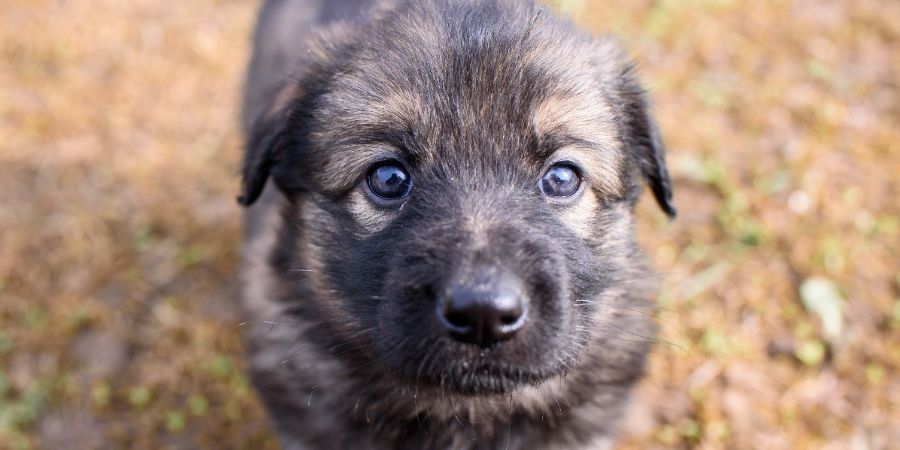
The First 48 Hours with a New Puppy
Once you bring your puppy home, the real work begins. The first 48 hours are vital for setting up a happy and healthy relationship between owner and pup, as well as the pup’s relationship to their new environment!
What are the First Things to Do When You Get a Puppy and Bring it Home?
Step 1: Make sure your house is puppy-proofed and stocked up on the right supplies before their arrival (as we mentioned earlier).
This way, they have everything they need to feel comfortable in your home right from the get-go.
Step 2: Make sure to introduce them to their new environment gradually.
You’ll want to start off by bringing your pup outside for potty breaks as frequently as possible. It’s also a good idea to take them on short walks around the neighborhood or let them play in the backyard, so they can get used to their surroundings and learn some basic commands.
If you have children and/or other pets, it’s critical that you SLOWLY introduce them to the pup as well. Don’t let them overwhelm your puppy! Remember: children don’t always know how to properly handle a puppy, and existing pets could feel territorial.
So, take it slow and watch for signs of stress or aggression – both from your puppy and the other animals in your home. If you start to notice signs of distress, take a break for a few hours before continuing with introductions.
What Children Need to Know When Getting a Puppy
Having a puppy can be an exciting experience, especially for kids. However, it’s important to talk to them about the responsibility that comes with owning a pet before getting one.
Explain to them that puppies need lots of attention and care, and they’ll often require training and regular vet visits.
You should also go over basic safety measures, such as not picking up a puppy unless you know how to hold them properly, and never leaving them unattended in the yard or home.
Finally, discuss expected behaviors, such as no running around near the pup or playing too rough with them. Explain that puppies need gentle handling so they’ll learn to trust people.
By taking the time to talk to your children about these issues, you can help ensure that everyone in your family is prepared for the responsibilities of pet ownership!
Step 3: Spend plenty of time bonding with them by providing lots of love and attention.
This will create a strong bond between you and your pup that will last for years to come!
Puppy Care Guide: Week by Week
The first few weeks with a new puppy can be overwhelming if you’re not prepared – but don’t worry! We’ve put together an easy-to-follow guide that will help ensure you and your pup have the best start.
Week 1
This is the perfect time to get your pup used to their new environment and establish routines. So, start by getting them used to basic commands such as sit and stay.
Focus on positive reinforcement and provide lots of treats when they get it right! Additionally, you’ll want to set a potty-training schedule and begin socializing your pup with people and other pets.
Week 2
By now, your pup should be getting more comfortable in their new home and confident in basic commands. Continue with potty-training and socialization, as well as introducing them to simple crate training. This will help your pup start associating the crate with a safe and cozy place – not a place of punishment or isolation.
Week 3
It’s time to start teaching your pup basic manners, such as not jumping or barking. You can also begin introducing toys and other items that will make them feel comfortable in their new home.
Finally, don’t forget to take lots of potty-training breaks and short walks outside so they can explore their surroundings!
Week 4 and Beyond
By now, your pup should be getting the hang of it! Continue reinforcing positive behaviors and rewarding them with treats when they do something good.
Additionally, this is a great time to start enrolling them in puppy classes to help with socialization or obedience training. You can also continue introducing them to different places, people, and animals to help ensure they feel comfortable in any environment.
Special Timing Considerations
Within the first year and a half of your puppy’s life, there are a few things that’ll need to be done once the puppy reaches the right age. So, mark these in your calendar so you can be prepared:
- Approx. 8 weeks old – Get your puppy microchipped if they haven’t been already (optional)
- 8 weeks old – First round of mandatory vaccination shots
- 8-9 weeks old – Start potty-training and basic commands
- 12 weeks old – Get your puppy professionally groomed for the first time
- 12 weeks old – Second round of mandatory vaccination shots
- 16 weeks old – Begin obedience classes or other training
- 16 weeks old – Third round of mandatory vaccination shots
- 6-9 months old – Get your puppy spayed or neutered (check with vet for recommended age to do this, depending on the puppy’s breed)
- 18 months old – Schedule a visit to the veterinarian for a checkup
- Every year after that – Schedule a vet visit for checkup and any necessary vaccine updates
PRO TIP: Want to be able to groom your dog yourself? Learn everything you need to know – and earn an internationally-recognized certification in the process – with QC Pet Studies’ self-paced, online Dog Grooming Course!

Do’s and Don’ts of Getting a Puppy
DO:
- Put LOTS of effort and research into the different breeds and finding one that fits your lifestyle!
- Make sure you’re getting your puppy from a reputable, humane source!
- Secure pet insurance!
- Set up a potty-training schedule to get your pup used to going outside for their business!
- Enforce naps, especially if your puppy shows signs of being overtired and/or cranky!
- Invest in the right supplies before bringing your puppy home!
- Take your pup to the vet for regular checkups and vaccinations!
- Spend plenty of time bonding with your new pet!
- Enroll them in puppy classes or other dog training courses!
- Start socializing them with people and other animals at a young age!
- Get them spayed or neutered!
- Introduce them to the grooming process at a young age (and then groom them on a regular basis)!
- Provide lots of love, patience, attention, and praise – especially when they’re trying to learn how to do something good!
DON’T:
- Buy your puppy from a pet store and/or support puppy mills.
- Over-exercise or overfeed your puppy – they’re still growing and this could cause problems later on.
- Leave your puppy alone for extended periods of time – they need companionship and mental stimulation.
- Leave them unsupervised when they’re outside – you need to be there to ensure their safety.
- Punish or reprimand them harshly when they make mistakes – positive reinforcement is the number one way to help them learn.
- Assume all puppies are the same – they have different personalities and will need different levels of training.
- Bring home a puppy before being 100% prepared for them – make sure you have all the necessary supplies, insurance, and information about their breed!
- Buy a puppy if you don’t have the money to take care of them and provide for their needs.
- Forget to give them plenty of praise and love when they do something right.
Frequently Asked Questions
Finally, let’s wrap things up by answering some of the most frequently asked questions about getting a puppy…
Q: How long does it take to potty-train a puppy?
A: It depends on how much time and effort you put into it. But generally speaking, it takes around 4-6 months for puppies to become completely potty trained.
Q: You’ve never potty-trained a puppy before – what should you do?
A: If you’re unfamiliar with the potty-training process, here’s what you need to know:
- Create a regular routine for your puppy
- Take them out to their designated potty spot every few hours (at least three times a day) and after they eat or drink
- Use positive reinforcement when they do something right
- Don’t raise your voice or punish them when they make mistakes
Q: Where should your puppy sleep the first night they’re brought home?
A: The best place for a puppy to sleep the first night is in a crate or kennel that’s been lined with comfortable bedding. This crate or kennel should be placed in your bedroom or another area of the house where they will feel safe.
Q: Should you ignore your puppy crying at night?
A: No, it’s important to not ignore your puppy’s cries at night – especially during their first few nights in their new home.
Remember: your puppy is basically a baby, and they’ve just been taken away from their mother and siblings. Chances are, your puppy is feeling scared and alone. So, while you don’t want to reward them for crying, it’s still important to provide them with comfort and reassurance in these moments.
This way, they can adjust better… And otherwise, their confidence can suffer and behavioral problems might start to emerge.
Furthermore, your puppy may be crying at night because they’re thirsty, hungry, or need to use the bathroom. So, it’s important to be attentive and take care of their needs in order to keep them happy and healthy.
Q: Your puppy is tired during the day but refusing to sleep. When trying to enforce naps during the day, should you let your puppy cry in their crate?
A: No, as we mentioned, you should never let your puppy cry in their crate. Instead, you should make sure to provide them with a cozy and comfortable environment that’s free from distractions. Once they’re settled in, offer them some food or a toy – this can help to keep them occupied until it’s time for their nap.
If all else fails, it might help to take your puppy outside for a walk or let them play in the yard. This can tire them out and make it easier for them to fall asleep when they get back inside!
Q: How long can a puppy be left alone during the day?
A: In general, puppies should not be left alone for more than 2-3 hours during the day. If you absolutely have to leave them alone for longer than this, it’s important to make sure they have access to food and water – plus, a comfortable place to rest without being disturbed or overheated.
And of course, it’s important to make sure that someone is available to take them outside for potty breaks when needed.
By following these tips, you can ensure your puppy’s health and safety – no matter how long they’re alone during the day!
Q: How often should you groom your puppy?
A: This depends on what aspects of grooming you’re referring to. However, this is a pretty good rule of thumb:
- Bathing: once every 1-2 months
- Brushing: once a week
- Trimming nails: as needed
- Brushing teeth: several times a week
- Cleaning ears: at least once a month
Ultimately, it’s important to groom your puppy regularly in order to keep them looking and feeling their best. That being said, if your puppy is not used to the grooming process, it’s important to introduce it slowly and in a positive way.
This is the best way to ensure your puppy doesn’t become too stressed or overwhelmed during the process!
Q: How often should you feed a puppy?
A: Generally speaking, puppies need to eat 3-4 times per day. This gives them the energy they need to grow and stay healthy. However, it’s important to remember that every breed is different. So, it’s best to consult with your vet or breeder for specific feeding instructions.
Q: How can you know the right type of food to feed your puppy?
A: It’s important to choose the right type of food for your puppy in order to ensure they get all the nutrients they need. Start by reading the labels on pet food to make sure it contains high-quality ingredients and has been specifically formulated for puppies.
You can also talk with your veterinarian or breeder about what type of food would be best for your pup’s particular breed. That way, you can be sure they’re getting the right type of nutrition – and that it’s tailored to their needs!
Remember: always make sure to follow the feeding instructions on the package, and never overfeed your puppy. This will help them stay healthy and happy for years to come!
Q: How often should you walk your puppy?
A: Firstly, it’s important to know that you shouldn’t be exposing your puppy to the outdoors until they’ve been fully vaccinated (a.k.a. usually around 16 weeks of age).
But once your puppy is ready for outdoor adventures, you should aim to take them out for at least two walks a day. To begin with, these should be relatively short in length and slowly increase as your pup gets more comfortable walking on their leash and exploring the outdoors.
Also, remember to bring something for your puppy to explore during their walks – like a toy or some treats. This will help them stay active and stimulated while they get used to the leash!
Overall, it’s important to ensure that your pup is getting enough exercise in order to keep them fit and healthy!
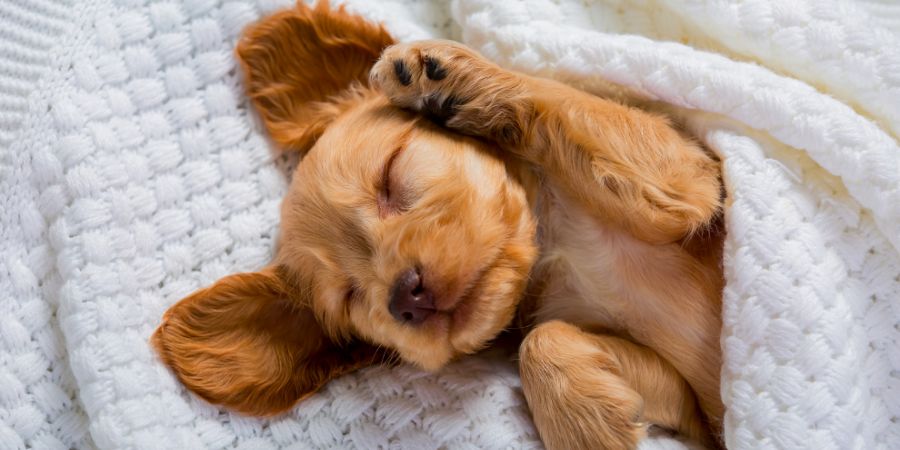
Conclusion
In terms of what to know when getting a puppy, the biggest takeaway is that they require a lot of care and attention. It’s important to provide them with the right type of food, entertainment, exercise, and grooming in order to ensure their health and safety.
Also, remember that puppies need special attention when it comes to leaving them alone during the day – so try to keep this to a minimum, if at all possible.
No matter what, it’s important to always show love and kindness for your pup. This will help create a strong bond between you and ensure that your furry friend is happy and healthy for years to come!
By following these tips, you can be sure that getting a puppy will be an incredibly rewarding experience – both for them and yourself!
